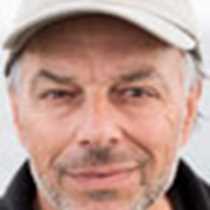The Trip So Far, Part 1. At Sea
On our first full day headed away from South Georgia, the seas grew increasingly kinder to our floating 5-star hotel. But that’s about all we noticed, because we traveled in a whiteout cocoon of fog. Steve Maclean gave a talk about Larsen’s importance to Antarctic exploration and development. Sue Perin spoke of cold-weather adaptations of seals and penguins. And I did a presentation based on my recent book, The View From Lazy Point. That’s the end of my daily report. Thank you very much.
So with time and space to spare, I’d like to offer a little retrospective on our great southern sojourn, our Natural Mystery Tour, and the conservation issues—implied and explicit—behind some of what we’ve been seeing.
Subtle conservation issues have been with us throughout. Most of what we saw and heard about, from penguins to rats, is being affected by climate change. The rats stand to have a good time as glaciers recede and they can reach more of South Georgia. It’s now a rat race between eradicators and shrinking glaciers. And the prospects of warming for animals adapted to cold are not positive. Nearly everything we saw depends on an animal we did not see that depends on sea ice: krill. And sea ice is shrinking too.
We happened to be here on October 31 when the United Nations announced that the human population has blown past 7 billion, making it—speaking for myself—a very scary Halloween indeed. The implications encompass everything.
Of the 7 billion people—for whom we are surrogate travelers—most have never heard of the creatures we saw on this trip. Their extinction would create scarcely a ripple across most human minds. If people care to protect only what they love, what hope is there for the vast majority of animals whose existence means so little to so many?
That, I suppose, is why we’re here—to create a little hope. We must keep in mind that the abundance we saw is no guarantee of future abundance. But we must also keep in mind that natural resilience can confound pessimism. Whales are still essentially gone from these waters. But the fur seals have risen from the dead.
But being aware of these issues doesn’t detract from being here. It’s always wonderful to be close to the animals. Here where they don’t fear us, the intimacy, the eye-to-eye looks, are very special. I hope we find a way to live up to their trust.
Seven billion people require a lot of food. Remember the Magellanic Penguins we saw on the Argentine coast? Dee Boersma of the University of Washington has documented that many skipped breeding in 2011. “And those that came,” Dr. Boersma has said, “were skinnier than they normally would be, and the females laid smaller eggs.” That’s because anchovies that those penguins eat are being over-fished. Dr. Boersma has said. “We’re harvesting more and more anchovy out of the ocean to feed pigs and chickens in China and salmon in Norway and Chile and other places. And that’s anchovy that can’t go to penguins. As we take more and more food, penguins are going to be in poorer condition and have a harder time making a living.” [see http://bit.ly/p3AhHu]
We’ve seen and visited many albatrosses. And surely, an albatross colony is one of the greatest spectacles in wild nature. The Falklands have been home to the largest albatross population in the world. But between the mid 1990s and the mid ‘00s, the Falklands’ Black-browed albatrosses lost about 38,000 pairs—nearly one adult bird per hour.
Yet in recent years, that decline seems to have been arrested. Boats fishing around the Falklands must now use streamer lines behind the vessel to scare and discourage birds from approaching close behind the boat. Boats using this technique kill only about two percent as many albatrosses as do boats not using streamer lines. So, the decline in the Falklands’ Black-browed Albatross population appears to have stabilized.




